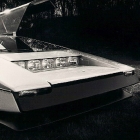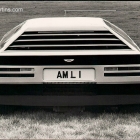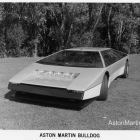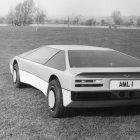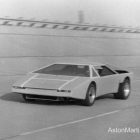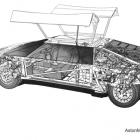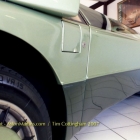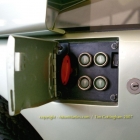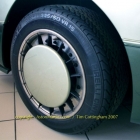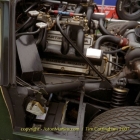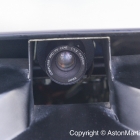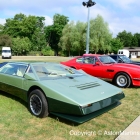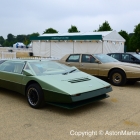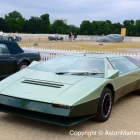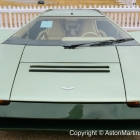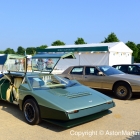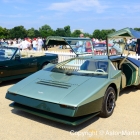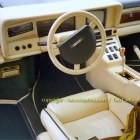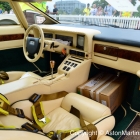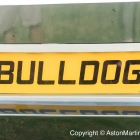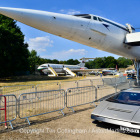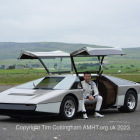This drivable concept car was developed to demonstrate the ability of the factory to produce a supercar for the 80’s. William Towns styled the Bulldog soon after finishing the AM Lagonda and thus created the ultimate wedge shaped sportscar design – with initial engineering work by AML chief engineer, Mike Loasby. When Loasby moved to work for DeLorean in 1979, the work to finish the car was given to Keith Martin who developed the car over the next three years. It was strongly supported by the then Managing Director of AML, Alan Curtis, who named the car after an aeroplane that he flew called the Scottish Aviation Bulldog. Within the factory it was known by the code name K-9, perhaps after Dr. Who’s robotic dog. Certainly the area of the factory that the car was built was known as ‘the Kennel’.The Bulldog is powered by a twin Garrett AirResearch turbocharged 5.3 litre V8 originally with Bosch Fuel Injection from the DBSV8. Power output on the test bed was claimed to be excess of 700 bhp, although installed in the car this would have been in the region of 600 bhp. I have read elsewhere on the web that the theoretical top speed is in the region of 237mph, a think this is a little optimistic; I would guestimate upto 210 mph. During testing at MIRA ‘only’ 192 mph was recorded so Bulldog was the fastest V8 powered AM, loosing out to the AMR1 with a confirmed 217mph. It was however well and truly trounced by the One-77 and the Valkyrie.
Pirelli P7 tyres are used all round fitted to Compomotive split-rim alloy wheels. Around the circumference are fitted wheel disks with blades to direct cooling air to the brakes. This feature was later seen on the successful racing Porsche 956 sportscar. Front wheels are shod with 225/50’s whilst rear wheels have massive 345/35 tyres.
Very serious consideration was given to a small production run of between 12 and 25 examples but the car remains totally unique. When AML changed hands in 1981, the new Chairman, Victor Gauntlett considered the company had more pressing problems and the Bulldog was sold off for a reputed £130,000 to a Middle Eastern Prince.
Of special note were the pair of massive power operated gullwing doors which took the height of the car from just over a metre to nearly two. The mechanism is actually based on that used power the V8 Volante hood mechanism.
This left hand drive car of both great length and width only seats two occupants. Instrumentation was provided by the then ‘state of the art’ LED technology and touch type sensors straight out of the new AM Lagonda.
Many detailed changes occurred in the 40 years that has elapsed from the cars unveiling. The silver over light grey machine was repainted during 1981 to two tone metallic green. The original brown leather of the interior was replaced by stone leather piped in brown. Other additions to the car included (rather bling) gold plated trim to switches and gear stick, roof mounted stereo, ugly but useful rear view mirrors and a TV showing the rear-view of the car.
The black and white 1980 press images below were taken by AML photographer, Roger Stowers back in 1980 and are very interesting to compare to the more recent photographs.
I first photographed this unique car during a very rare public appearance in the AMOC marquee at the 1997 Coys Festival, Silverstone and subsequently at the Stratton Motor Company open day, 1998. Interestingly at this time, the car has lost the fuel injection system initially fitted and had quad Weber carburettors. These were, I think of the side draught type and were paired up within the ‘V’ unlike the down draught type fitted in a line down the centre as would be found in a V8 Vantage. More recently, the Bulldog was one of the star cars at the Aston Martin Centenary Celebration at Kensington Palace in 2013. At this time, the car was still a non-runner but attempts to get it moving under its own power again continued through 2014 to no avail.
Despite being only an engineering exercise, interest in this drivable usable concept car remains extremely high. Up until 2016, the Bulldog remained the only publicly seen fully engineered mid-engined Aston Martin. The mid-engine version of prototype V8 Vantage, AM305 from 2000 was dropped before ever being seen by the public and the DP-100 Vision Gran Turismo only exists in the virtual world and as a full-sized model. The spiritual successor to the Bulldog announced in 2016 – Aston Martin together with Red Bull Technologies unveiled the mid-engined AM-RB 001, hypercar which went into limited production in 2021.
In 2020, Bulldog was sold to a collector and moved to Classic Motor Cars in Bridgenorth to undergo an extensive restoration. I was extremely fortunate to see the car midway through the first year of the restoration in September 2020. The plan was to bring the car back to 1980 spec with modern fuel injection and for it finally to crack the 200 mph barrier.
By late Summer 2021, the car was about finished and was put on display at the Hampton Court Concours of Elegence. It was also seen at the 2022 AMHT Aston Martin Festival at Brooklands together with Concorde.
By June 2023, the car was prepared to break the 200 mph barrier.




